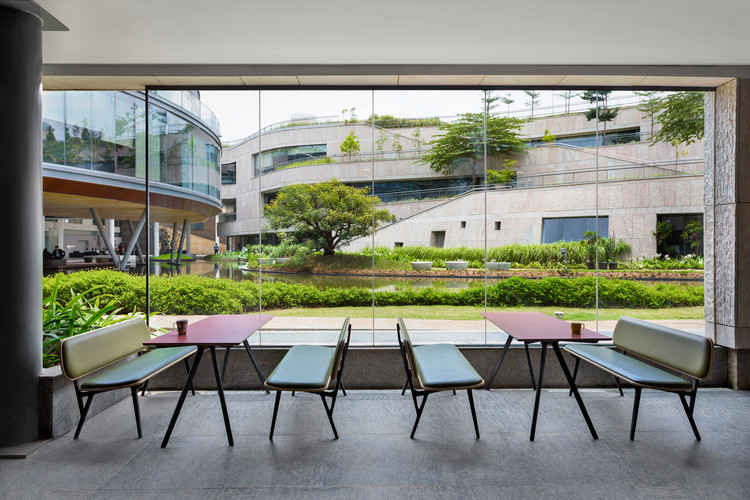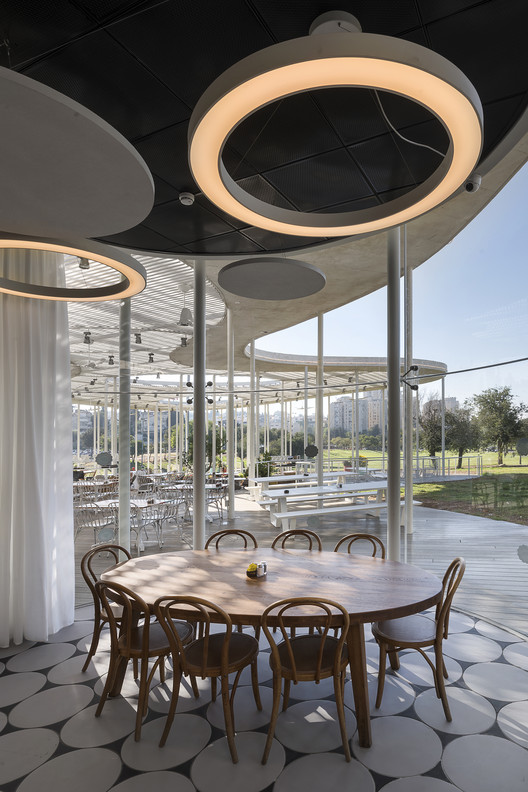Vishranthi Office KSM Architecture
2014-07-17 01:00
Text description provided by the architects. SITE CONTEXT
这座商业大厦位于钦奈劳埃德路的一段繁忙地段,坐落在一排老住宅、几套公寓、几家零碎的小商店和商店中间,点缀着繁忙的街景。该建筑位于主干道的拐角处和一条旁巷,朝北向主干道,向东向旁巷,向西和向南向两处老住宅。
Located on a busy stretch of Lloyds Road in Chennai, this commercial building nestles itself among a line of old residences, a few apartments and scrappy little shops and stores dotting this busy streetscape. Sited on the corner of the main road and a by lane, the building faces north towards the main road, east towards the by lane, west and south towards two old residences.
除了为办公室室内提供透明的楼板外,我们的主要建筑意图是采用一种被动的方法来提供更好的室内环境。提供均匀分布的自然光,减少空调要求的负荷,并尽可能避免来自下面街道的噪音。
Our main architectural intent apart from providing the clear floor plate for the office indoor, was to work on a passive method of providing a better indoor environment. Provide well distributed natural light, reduce the load on the air conditioning requirement and ensure the noise from the street below was kept out, to the best extent possible.
这种建筑意图,表现在建筑的北面、东侧和西侧的表皮墙的形式上。我们的第一个参照点是传统的砖石幕墙。担架球场,交错在每一个交替的课程,创造了大众和虚空的游戏。我们采取了这个基本的贾利屏幕几何,并试图调整它,以适应我们的要求。
This architectural intent, manifested itself in the form of a skin wall along the north, east and western sides of the building. Our first point of reference was a traditional brick jali screen wall. Stretcher courses, staggered at every alternate course creating the play of mass and void. We took this basic jali screen geometry and looked to tweak it to suit our requirement.
我们的第一个材料选择是用一个更平整更长的砖块(300Wx100Dx50H)。砖是空的,两个洞沿砖的长度运行。我们之所以选择这种砖,是因为它的重量轻,它的空腔允许较小的热增益,也因为它的精确尺寸和成品边缘。
Our first material choice was to go with a flatter and longer brick (300Wx100Dx50H). The brick is hollow, with two cavities running along the length of the brick. Our reason for choosing this brick, is because of its lightweight nature, its air cavity which allows for lesser thermal heat gain and also because of its accurate dimensions and finished edges.
建筑物的整体正面被分割成600毫米的清晰面板,每个面板上都有白色的铝制毛条,用来定义边缘。毛刺之间的填充皮肤间隙分为两种不同的类型。一种用于照明的面板和一种性能雅利屏幕面板。
The overall facade of the building is divided and broken down into clear panels of 600mm each with white aluminium mullions that define the edges. The infill skin space in between the mullions is divided into two distinct types. A panel for light and a performance jali screen panel.
光的面板均匀地分布在地板上,即使是自然光也可以通过地板空间分布。这样,室内空间内就不会产生明显的亮点和黑点。铝制细木工从光束底部到地板水平,通过反射白色地板和天花板,允许光线反弹和倍增。
The panels for light are distributed evenly across the floor plate, allowing for even natural light to be distributed through the floor space. This way no distinct bright spots and dark spots are created within the indoor space. The aluminium joinery which spans from beam bottom to floor level, allows the light to bounce and multiply, by reflecting off the white coloured floor and ceiling.
PERFORMANCE JALI SCREEN PANEL
PerformanceJali屏幕面板本身由三个不同的区域组成。100 mm外露砖墙、50 mm自由通风风洞和200 mm双侧抹灰混凝土砌块工作墙在办公室室内侧。空心砖芯的通风特性,砖与砌块之间的空隙和通风腔,都保证了从外表面向室内环境直接传递的热量很少。事实上,内部砌块的工作墙,几乎从来没有收到直接的阳光在一天中的任何时候,因为贾利屏幕边缘浸泡在热和通风口通过各种空腔。这将大大减少室内空间内辐射的热量,进而减少空调系统的负荷。
The performance jali screen panel in itself comprises of three distinct zones. The outer exposed brick jali screen wall of 100mm, a 50mm freely ventilated air cavity and a 200mm two side plastered concrete block work wall on the office indoor side. The ventilating nature of hollow brick core, the voids between the bricks and the ventilated air cavity between the brickwork and the block work all ensure that there is very little direct heat transferred from exterior face to the indoor environment. In fact the inner block work wall, almost never receives direct sunlight at any time of the day, as the jali screen edge soaks in the heat and vents it out through the various air cavities. This will greatly reduced the heat radiated within the indoor space and in turn will reduced the load on the air-conditioning systems.
在建筑物的北面是主干道,这是相当繁忙的,有时会相当嘈杂。使用相同的面板表演贾利屏幕到北部的脸,我们正在寻找在很大程度上降低这种噪音的穿透水平。与像素相关的立面与其空气腔,允许这些噪音干扰衰减和褪色之前,他们进入办公室内部,从而允许室内空间保持相对干扰,不受不必要的噪音。
On the northern face of the building is the main road, which is fairly busy and can be quite noisy at times. Using the same panelised performance jali screen to the northern face, we are looking to reduce the level of penetration of this noise to a great extent. The pixelated facade with its air cavities, allows these noisy disturbances to attenuate and fade before they enter the office interior, thus allowing the indoor space to remain relatively disturbance free from unwanted noises.
在城市情况下,贾利屏风墙面临的一个标准问题是鸽子和其他类似鸟类的栖息问题。这一直是一个问题,并已在许多方面得到解决,如使用尼龙导丝,金属钉,低压电线等。了解这个问题,是选择50毫米宽砖的另一个关键原因。砖块是用水泥基粘合剂粘结的,而不是传统的10毫米迫击炮接头,这样我们就可以确保空隙的高度略大于50毫米。50毫米太小,多产的筑巢者如鸽子栖息,在某种程度上,使这贾利屏风墙栖息。
A standard problem faced with jali screen walls in urban situations, has been the roosting of pigeons and other similar birds. This has always been a problem, and has been tackled in many ways, like using nylon guide wire, metal spikes, low voltage electrical wires etc. Knowing this problem, was another critical reason in choosing the 50mm wide brick. The bricks are bonded by a cement based adhesive, not a conventional 10mm mortar joint, allowing us the ensure the voids are just fractionally larger than 50mm in height. 50mm being too small for prolific nesters like pigeons to roost, in a way made this jali screen wall roost-resistant.
MODULAR ZERO WASTAGE JALI SCREEN
砖木筛网的建造,是为了确保我们有接近零的材料损耗。300 Lx150Bx50H砖的充分使用以及现场切割尺寸230毫米和70毫米,确保没有浪费。用于粘合砖的粘合剂也作为一层薄的3mm厚,与一个小的铲子。没有拆除额外的迫击炮,没有溢出,也没有浪费。每块砖玉筛进一步模块化成600 mm宽的铝制板。
The construction of the brick jali screen, was to ensure that we have near zero percent wastage of material. The 300Lx150Bx50H brick is used in full as well as in site cut sizes of 230mm and 70mm, ensuring that there is no wastage. The adhesive used to bond the brick is also applied as a thin layer 3mm thick, with a small trowel. No removal of extra mortar, no spillage and no wastage. Each brick jali screen was further modularized into panels of 600mm width bound by aluminium mullions.
Architects KSM Architecture
Location 351, Lloyds Road, Padupet, Gopalapuram, Chennai, Tamil Nadu 600014, India
Category Institutional Buildings
Design Team Siddarth Money, Sriram Ganapathi, K.S Money, G. Theivanayagee, S.Seran, P.Mathivannan
Photographs Vishranthi Homes
 举报
举报
别默默的看了,快登录帮我评论一下吧!:)
注册
登录
更多评论
相关文章
-

描边风设计中,最容易犯的8种问题分析
2018年走过了四分之一,LOGO设计趋势也清晰了LOGO设计
-

描边风设计中,最容易犯的8种问题分析
2018年走过了四分之一,LOGO设计趋势也清晰了LOGO设计
-

描边风设计中,最容易犯的8种问题分析
2018年走过了四分之一,LOGO设计趋势也清晰了LOGO设计






















































